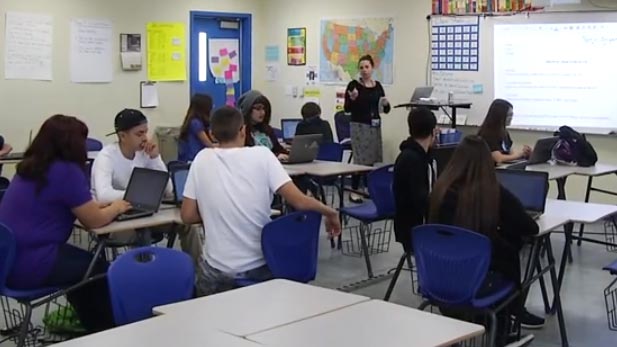 Freshman literature teacher Michelle Callahan-DuMont at Sunnyside High School.
Freshman literature teacher Michelle Callahan-DuMont at Sunnyside High School.
Listen:
Voters in Sunnyside Unified School District said 'no' to more money for the fourth time in five years in last week’s election.
The district was one of the dozens in the state to ask for additional funds through voter approved bonds or overrides. Districts have come to rely on the money for school maintenance, teacher salaries and programs such as fine arts and all-day kindergarten.
“The sustainability of those (programs) are going to be a challenge as our budget capacity is not there to continue to support the programs we know are important to our community,” said Sunnyside Superintendent Steven Holmes.
 Note: The district did not pursue an override in 2014. In 2011, voters approved a $88 million bond issue.
Note: The district did not pursue an override in 2014. In 2011, voters approved a $88 million bond issue.
Sunnyside asked voters to approve a 15 percent maintenance and operations budget override. An override gives the district permission to exceed the State’s budget limit. It would have given the district an extra $12 million.
The first Sunnyside governing board meeting after elections showed the divisions that remain in the district.
It started out celebratory with the recognition of students and teachers for recent successes. Then call to the audience started:
First up, Richard Hernandez, a member of a committee that campaigned against the budget override.
“The reason I believe it failed is that we still have that stigma, that we are about administrators and not about teaches and the classroom,” Hernandez said.
“I’m here because I’m no longer afraid, rather tired and beyond frustrated,” said Lisa Hernandez, a fifth grade teacher.
“I was disheartened that that the override did not pass,” said Yolanda Herrera, a Sunnyside alumna and self-described “education advocate.”
Herrera is at most governing board meetings, in part, because her sister, serves on the board. That does not mean she voted for the override without scrutiny.
“Initially I thought it was a bit premature given the fact that we just started with a new superintendent.”
Change in the district
Superintendent Steven Holmes’ first day was in July– a week after the governing board approved the override for the fall election
His hire capped a wave of upheaval in the district that saw his predecessor, Manuel Isquierdo ousted and two governing board members recalled in May 2014.
Herrera and district teachers think Holmes is starting to make a difference.
“I think we are seeing a lot more positive changes in the sense that morale has increased,” Herrera said. “People are doing a lot more working together we’re not seeing the same little bullying techniques we’re seeing in the past.”
Mary Martinez has taught in the Sunnyside district for 14 years and is also president of the teacher’s union.
“I was hopeful that with the new superintendent there was this hope out there for teachers and for students and for parents,” Martinez said.
The teacher's union banded together to stuff envelopes and canvass neighborhoods in support of the override.
“It was hard to get people to understand the importance of the override when many of them didn’t realize it was going to be on the ballot,” Martinez said.
Consequences in the classroom.
The extra money comes from increased property taxes in the district– an estimated $200 a year for the average homeowner.
The $12 million would have restored music and art teachers, librarians, counselors and went to maintaining programs including full-day kindergarten and athletics.
“For sure we’re not going to be able to restore what was committed in that override because we don’t have the budget capacity to do so,” Holmes said.
“I’m hoping we can sustain some of those programs by looking more creatively at some cuts, but at the end of the day it is going to be a loss for us.”
Part of the challenge is that the district does not yet know how much it will have to cut. The state changed how it funds schools last year, which means districts with declining enrollment, like Sunnyside, will see a loss of students change the budget in real time.
“I have to not only take into account the 650 students lost this year, I have to also predict a potential loss for next year so at the start of the school year,” Holmes said. “I’m actually taking a double loss.”
If voters approve an education funding plan in May’s special election, Sunnyside expects a $2.5 million boost.
When Sunnyside creates its budget next year, Holmes estimated cuts could range from $700,000 to $5 million dollars.
Holmes said the district is committed to placing teachers on a salary schedule that would compensate them based on their years of experience.
Sunnyside plans to include both staff and the community in conversations about setting the budget for next year.
“We need to be real clear on how we’re spending our money and more importantly we have to show that in very transparent ways,” Holmes said.
Hear the full interview with Sunnyside Superintendent Steven Holmes:

By submitting your comments, you hereby give AZPM the right to post your comments and potentially use them in any other form of media operated by this institution.